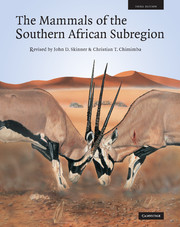Book contents
- Frontmatter
- Contents
- Editorial board
- Acknowledgements
- Foreword
- Preface
- The Mammal Research Institute
- R. H. N. Smithers
- Explanatory notes
- SUPERCOHORT AFROTHERIA
- COHORT PAENUNGULATA
- SUPERCOHORT EUARCHONTAGLIRES COHORT GLIRES
- COHORT EUARCHONTA
- SUPERCOHORT LAURASIATHERIA
- COHORT FERUNGULATA
- Order CARNIVORA
- Order PERISSODACTYLA
- Order SUIFORMES
- Order WHIPPOMORPHA
- Order RUMINANTIA
- Bibliography
- Appendix 1 Conservation status of southern African mammals
- Appendix 2 Colloquial names
- Index of scientific names
- Index of English colloquial names
- List of subscribers
- Plate Section
- Plate Section
- Plate Section
- Plate Section
- Plate Section
- Plate Section
- Plate Section
Order PERISSODACTYLA
from COHORT FERUNGULATA
Published online by Cambridge University Press: 05 July 2013
- Frontmatter
- Contents
- Editorial board
- Acknowledgements
- Foreword
- Preface
- The Mammal Research Institute
- R. H. N. Smithers
- Explanatory notes
- SUPERCOHORT AFROTHERIA
- COHORT PAENUNGULATA
- SUPERCOHORT EUARCHONTAGLIRES COHORT GLIRES
- COHORT EUARCHONTA
- SUPERCOHORT LAURASIATHERIA
- COHORT FERUNGULATA
- Order CARNIVORA
- Order PERISSODACTYLA
- Order SUIFORMES
- Order WHIPPOMORPHA
- Order RUMINANTIA
- Bibliography
- Appendix 1 Conservation status of southern African mammals
- Appendix 2 Colloquial names
- Index of scientific names
- Index of English colloquial names
- List of subscribers
- Plate Section
- Plate Section
- Plate Section
- Plate Section
- Plate Section
- Plate Section
- Plate Section
Summary
FOUR GENERA OF fossil rhinoceros are known from the early Miocene some 23 – 19 Mya, namely Brachypotherium, Aceratherium, Dicerorhinus and Chilotherium. Their ancestors are unknown but must have lived during the preceding Oligocene.
There are five extant species of rhinoceros: the white (or square-lipped) rhinoceros (Ceratotherium simum); the black (or hook-lipped) rhinoceros (Diceros bicornis); the Sumatran (or Asian two-horned) rhinoceros (Dicerorhinus sumatrensis); the Indian (or greater one-horned) rhinoceros (Rhinoceros unicornis); and the Javan (or lesser one-horned) rhinoceros (R. sondaicus).
The two species occurring in the subregion, C. simum and D. bicornis, arose from a common ancestor, and fossil remains recorded from Plio-Pleistocene beds some four to three million years old show that they occurred throughout Africa during this period. A fossil species, Ceratotherium praecox Hooijer & Patterson, 1972, whose remains have been recovered from fossil beds at Langebaanweg, was among the commoner of the large mammals in the assemblage, dating back some 7 Mya. It has four incisors, which are lacking in the extant C. simum.
Both the black and the white rhinos formerly occurred widely in the southern parts of Africa. The white rhino, however, never occurred very far south of the Orange River and was generally absent from the Free State and parts of the southern former Transvaal, although in the east it occurred throughout most of KwaZulu-Natal, except in the extreme south.
- Type
- Chapter
- Information
- The Mammals of the Southern African Sub-region , pp. 527 - 546Publisher: Cambridge University PressPrint publication year: 2005



